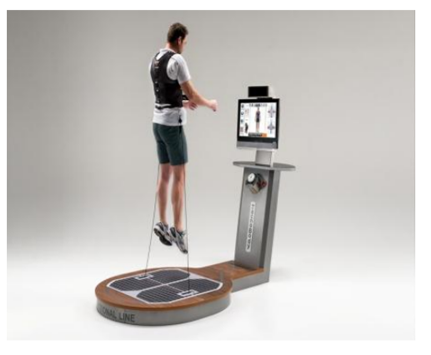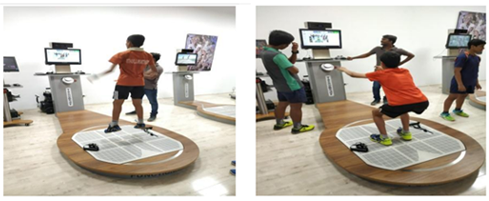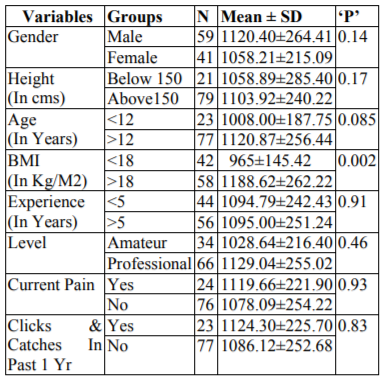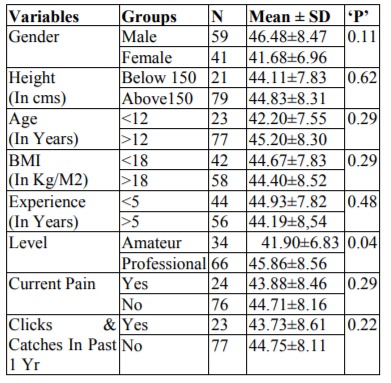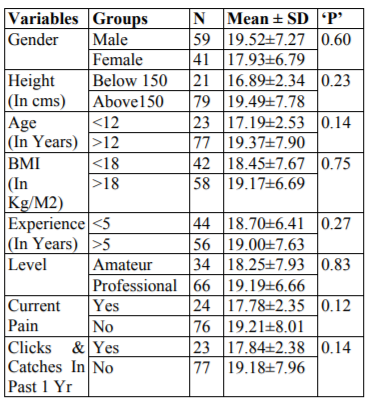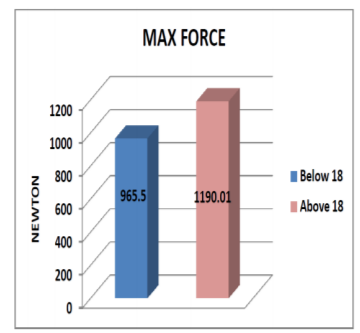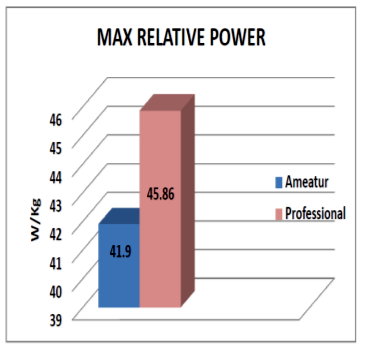Information
Journal Policies
Biomechanics of Squat Jump in Junior Badminton Players - Original
Article
Manan Vora1,3*, Digpal Ranawat1,2, Manit Arora1,3, Apoorva Tiwari2
2.Abhinav Bindra Targeting Performance, Bangalore, India
3.Fortis Hospital, Mohali, India
Copyright : © 2019 Authors. This is an open-access article distributed under the terms of the Creative Commons Attribution License, which permits unrestricted use, distribution, and reproduction in any medium, provided the original author and source are credited.
In badminton, the overhead jump smash is one of the most commonly used strokes. One of the key components of the smash is the ability to squat jump well before striking the shuttlecock. Improvement in squat jump could help improve the badminton overhead smash and overall improvement in performance. Accordingly, the study was proposed to analyse the biomechanics of squat jump in junior badminton players and understand its importance. A total of 100 players from South Asia between the ages of 8 and 15 years were analysed. Iso Lift system of Tecnobody Italy was used. Variables measured were gender, height, age, body mass index, and experience in years, level at which they play, current pain, and clicks & catches in the past 1 year. Our study showed that there was significant difference in maximum force of squat jump in terms of body mass index and in maximum relative power of squat jump in terms of level at which players compete. There are a variety of other factors which do not affect squat jump. There needs to be a greater focus on squat jump training with a specialised strength and conditioning coach as part of the development of junior badminton players.
Performance, Badminton, Racquet sport, Professional players, biomechanics,Research in Sports Medicine
1. Introduction
Badminton is a fast, interceptive racquet sport for two or four people, with a temporal structure characterized by actions of short duration and high intensity (Phomsoupha & Laffaye, 2015). The unpredictability of the opponent’s actions and the usage of feint strokes in elite badminton indicate inhibitory control as crucial for elite performance and it is recognized that a combination of excellence in technical, tactical, anthropometrical, physical and mental skills is needed for elite sports performance (Elferink-Gemser, Jordet, Coelho-e-Silva, & Visscher, 2011).
Among badminton skills, the forehand overhead smash is one of the typical techniques, and is the most powerful stroke (Tsai, Chang, & Huang, 1998). It is the second-most frequent shot in badminton with 20% of the badminton strokes in a game (Hong & Tong, 2000). It can be divided into two types, the stand smash and the jump smash (Tsai et al., 1998). Biomechanics of the racquet and shoulder component of the forehand overhead smash have been extensively studied (Poole, 1970)(Tsai, Huang, Lin, & Chang, n.d.)(Xiang Liu, Wangdo Kim, & John Tan, 2002). The jump smash in particular has been studied in detail and its importance in optimising badminton performance has been well documented (Waddell & Gowitzke, 2000) (Miller, Felton, McErlain-Naylor, Towler, & King, n.d.)(Miller, Felton, McErlain-Naylor, Towler, & King, n.d.)(Tsai, Yang, Lin, & Huang, 2008).
One study highlighted the relationship between jump testing in badminton and on-court jumping drills in elite badminton players. (Harvey, 2010). The author found that the results seem to be effected by the jump smash technique of the player and external factors during the on-court jumps. The results of his study attribute to the overall importance of jump testing for elite badminton players and he suggested that it is an important aspect to look at when forming a fitness testing battery for elite badminton players.
Previous studies on other types of jumps have been carried out. A study on the biomechanics of bounce drop jump and countermovement drop jump was conducted (Bobbert, 1990). Investigations on the neuromuscular and mechanical parameters in the development of reactive jumping ability as well as the innervation characteristics of drop jump have been carried out (Sialis, 2004) (Kyröläinen & Komi, 1994) (Martínez-López, Benito-Martínez, Hita-Contreras, Lara-Sánchez, & Martínez-Amat, 2012). Additionally, the effect of plyometric training protocols including a drop jump from 3-different heights according to the athlete’s body corpulence was also studied (Amara et al., 2016).
Other studies mainly focused on the effect of plyometric jump training on various aspects of health and performance. Certain studies investigated its effect on bone mineral content (BMC), lower extremity performance, and static balance in women (Witzke & Snow, 2000)(Kato et al., 2006), mechanical properties of muscle-tendon complex, muscle activities and performances during jumping (Kubo et al., 2007), muscle activation and architecture during vertical jumping and maximum strength (Kannas, Kellis, & Amiridis, 2012), and vertical jump height in healthy individuals (Markovic, 2007). Additionally, studies on plyometric training techniques for improving vertical jump ability and energy production in badminton players have been conducted (Ricard, 1998) (Arabatzi, Kellis, & Saèz-Saez De Villarreal, 2010) (Fröhlich, Felder, & Reuter, 2014).
There is limited research exploring the biomechanics of squat jump. One study measured force, velocity and power output during a squat jump (Samozino, Morin, Hintzy, & Belli, 2008) while another evaluated force and velocity parameters of vertical jump performance in countermovement jump and squat jump and compared results for sprint runners and volleyball players (JD Pupo, 2012). Another study evaluated the relation between the maximum mean propulsive power obtained in the loaded jump squat and half squat (Loturco et al., 2017). Thus, biomechanics of the squat jump in badminton players has not been extensively studied. Currently there is no consensus regarding which factors of a badminton player contribute to a better squat jump. The purpose of this study was to identify the modifiable and non-modifiable factors that contribute to players producing the ability to perform a squat jump with the aim of being able to inform coaches what to encourage in players, or recognise during the talent identification process.
2. Methodology
One hundred junior badminton players under the aegis of Badminton Association of India (BAI) were recruited for the study. Informed consent from the players, legal guardians and coaches was taken prior to participation. Approval from the BAI was taken prior to initiation of the study. All players were screened using a combination of a questionnaire and machine analysis.
The questionnaire consisted of a self-developed item set with focus on demographics, injury history, treatment history, playing career history and current injury state. The demographic data included age, sex, height, weight, and dominant hand. The injury history included questions regarding injuries in the past, their severity, whether they occurred during competition, training or daily activity, whether it prevented the player from taking part in a competition and/or training and/or daily activity, and if the pain was more during a particular badminton stroke. The treatment history questioned the form of treatment taken for the injuries, whether it was oral medication, physiotherapy, surgery, or any other. Playing career history included information regarding the age at which the player began playing badminton, whether the player has a dedicated coach and/or trainer, age at which he/she began playing badminton tournaments, and current professional level. Current injury state involved questions regarding any current pain faced by the player, and whether the player has experienced any clicks, cracks or catches in the body in the last 12 months.
The machine analysis was done by conducting a biomechanical assessment of squat jump. Iso Lift system of Tecnobody Italy (Figure 1) was used to assess the squat jump. The base of support of the Iso Lift system is a sensorized platform with four load cells which can detect the distribution of the athlete’s load to the ground in real time. The athlete was made to stand on the Iso Lift platform. Located in front of the system, the 3D camera scanned the athlete. This powerful camera allowed real-time reconstruction of every single movement of the athlete without the need to apply any marker on the body. The athlete performed the squat jump, and the results were available immediately on the screen. We recorded the maximum height, maximum force, maximum acceleration, and maximum relative power from each athlete’s squat jump. The test was done using the Tecnobody machine in Abhinav Bindra Targeting Performance at Padukone-Dravid Centre for Sports Excellence in Bangalore (Figure 2 and 3).
The data was categorized into variables (Table 1-4) and the resulting categorical data was analysed by computing the Mean, Standard Deviation and T-test to identify the level significance in kinematic variables (Maximum height, Maximum force, Maximum acceleration, Maximum relative power) using Microsoft Excel and SPSS (16.0) software.
3. Results
A total of 100 junior South Asian Badminton players underwent the assessment. Out of the 100 players, 59 were male players and 41 were female players. 90 of them were from India, 4 each from Nepal and Sri Lanka, while 2 players were from Maldives. The age group was between 8 and 15 years. The data is presented in Table 1, 2, 3 and 4.
Table 1 shows difference in maximum height (m) between various groups. Gender, height, age, BMI, experience in years, level at which they play, current pain, and clicks & catches in the past 1 year were the variables. However, none of the variables showed a significant difference between the groups.
Table 2 shows the difference in maximum force (N) between groups. The groups did not differ significantly in terms of gender, height, age, experience in years, level, current pain, and clicks & catches in the past 1 year. However, we did observe a significant difference in terms of BMI (Graph 1). 42 players were having BMI below 18 kg/m2 with mean maximum force of 965±145.42 kg/m2 whereas 58 players were having BMI above 18 with mean maximum force of 1188.62 ± 262.22 kg/m2. The significant difference was 0.002.
As seen in table 2, there is a significant difference in Maximum Force between players with BMI below and above 18.
Table 3 highlights the difference in maximum relative power [W/kg] between groups. We observed a significant difference in terms of level at which they play (Graph 2). 34 players were amateur and 66 were professional players. Mean maximum relative power in amateur players was 41.90 ± 6.83 W/kg and in professional players was 45.86 ± 8.56 W/kg. The significant difference was 0.04. There was no significant difference in terms of the other groups.
As seen in table 3, there is a significant difference in Maximum Relative Power between amateur and professional players.
Table 4 shows the difference in maximum acceleration [m/s2] between groups. There was no significant difference observed in terms of gender, height, age, BMI, experience in years, level, current pain, clicks & catches in the past 1 year.
As seen in table 4, there is no significant difference in Maximum Acceleration between the groups.
4. Discussion And Implications
Badminton warrants high demands, with a maximum heart rate of 190.5 beats/min, matches at an average ofover 28 minutes long, performance intervals of 6.4 seconds, and rest time of 12.9 seconds between exchanges (Cabello Manrique & González-Badillo, 2003). Studies have been done on the characteristics of competitive badminton in order to determine the energy requirements, temporal structure, and movements in the game that indicate performance level and to use the findings to plan training with greater precision (Cabello Manrique & González-Badillo, 2003). A previous study has reported the proposed method, solely based on three simple parameters (body mass, jump height and push-off distance), allows to accurately evaluate force, velocity and power developed by lower limbs extensor muscles during squat jumps. (Samozino et al., 2008).
The results of our study have highlighted certain factors that contribute to improving a squat jump, but it also sheds light upon the lack of importance given by players and coaches in including a conditioning program in an athlete’s training regimen that focuses on improving the squat jump. Based on our results, we found that there is a significant difference in maximum force of squat jump in badminton players with BMI below and above 18. We also found a significant difference in maximum relative power of squat jump in amateur and professional junior badminton players. Rest of the variables proved to be not significant with respect to maximum height, maximum force, maximum acceleration, and maximum relative power. The variables can be categorized into non-modifiable and modifiable factors. Non-modifiable factors include gender, height, age and years of experience. Modifiable factors include body mass index, level, current pains, clicks and catches in the body.
There was no significant difference observed between any groups in terms of maximum height, maximum force, maximum acceleration, and maximum relative power. The factors in question here were gender, height, age and years of experience. Common consensus would suggest male players, taller players, and older players would be having a superior squat jump compared to their female, shorter, and younger counterparts but we did not find a significant difference. This shows that gender, height, and age do not play a significant role in the ability to squat jump. We compared groups having less and more than 5 years of playing experience and found that there was no significant difference present. This shows that despite players having more than 5 years’ experience in the sport, they may not have access to strength and conditioning specialists who can help train them in improving their squat jump and that squat jump is not being given the importance it needs.
On comparing body mass index of players, there was a significant difference found between those with a BMI of less than and above 18 in terms of maximum force. Neural, mechanical and muscle factors influencing muscle force production have been documented (Kyröläinen & Komi, 1994). The authors studied maximal voluntary isometric force and the rate of force production of the knee extensor and the plantar flexor muscles in athletes and suggested that the differences in the isometric conditions could be explained by different muscle fibre distribution and different amounts of muscle mass. This theory supports our results regarding body mass index. Another related study investigated the effect of plyometric jump training during adolescent growth resulting in increased peak bone mass(Witzke & Snow, 2000).
Additionally, one study showed that low-repetition and high-impact jumps enhanced bone mass density at the specific bone sites (Kato et al., 2006). There was no significant difference between the two BMI groups in terms of maximum height, maximum acceleration, and maximum relative power. There was no significant difference between amateur and professional players in terms of maximum height, maximum force, and maximum acceleration. However, we did observe a significant difference between amateur and professional players in terms of maximum relative power. A study in the past found that athletes with higher mean propulsive power in the jump squat were capable of jumping higher and sprinting faster than their weaker counterparts (Loturco et al., 2017). The authors concluded that the jump squat should be preferred for assessing and possibly training elite athletes needing to improve speed-power related abilities. This highlights the importance of the squat jump and our results showed that professional players were jumping better than amateur players in terms of maximum relative power. There was no significant difference between players who were in current pain and those who were painless and between those who had experienced clicks, cracks or catches in the past 1 year and those who had not in terms of maximum height, maximum force, maximum acceleration, and maximum relative power.
Studies have mentioned the importance of the badminton jump smash and the co-relation between a jump squat and its importance in executing the smash to perfection, yet the lack of significant difference in various parameters of the squat jump in older players with more than 5 years’ experience and playing in the professional circuit shows the lack of strength and conditioning expertise available to them. Plyometric training has been the regimen of choice for improving jump performance. Research has shown that the increase of jumping performance after incline plyometric training should be taken into consideration by coaches to improve explosiveness of the plantar flexors (Kannas et al., 2012). Another study showed an eight week training program of Electrical Muscle Stimulation combined with plyometric exercises has proven useful for the improvement of every kind of vertical jump ability (Martínez-López et al., 2012). Additionally, plyometric training provides a statistically significant and practically relevant improvement in vertical jump height (Markovic, 2007). Athletes, coaches and sporting bodies need to recognise the importance of a dedicated strength and conditioning coach and realise that no detail is small enough in the overall development of an athlete.
There were some limitations we faced in our study. Firstly, the participants included players between the ages of 8 and 15 years only. Secondly, only squat jump assessment was done, whereas the machines have multiple tests for the assessment of different types of jumps to allow for further analysis of data. Thirdly, the study could have included a wider geographical area including players from more Asian countries.
This study opens up new grounds for further research. Further studies can address other variables not included in the present study. Additionally, targeted interventions are needed to improve squat jump of players and the effect of such improvements on performance need to be determined.
5. Conclusions
This study shows that there is a significant difference in maximum force in terms of BMI and in maximum relative power in terms of level at which players compete. Those having a BMI above 18 had better maximum force whereas professional players had better maximum relative power in their squat jump. However, no significant difference in maximum height, maximum force, maximum acceleration, and maximum relative power across other variables is a sign that squat jump is not being given the importance it needs. Understanding the need for strength and conditioning and its importance in overall improvement in badminton performance is vital and may help take their output to a whole new level.
Acknowledgements
We are grateful to the Badminton Association of India (BAI), Abhinav Bindra Targeting Performance, and Padukone-Dravid Centre for Sports Excellence (CSE) for their support in conducting this study. Images courtesy www.tecnobody.it and ABTP Centre, Bangalore.
References
- Amara, S., Mkaouer, B., Chaabene, H., Negra, Y., Hammami, M., & Bouguezzi, R. (2016). Effect of Plyometric Training on Young Athlete’s Performance According to Body Corpulence and Dropping Height. Journal of Athletic Enhancement, 4. https://doi.org/10.41 72/2324-9080.1000203
- Arabatzi, F., Kellis, E., & Saèz-Saez De Villarreal, E. (2010). Vertical Jump Biomechanics after Plyometric, Weight Lifting, and Combined (Weight Lifting + Plyometric) Training. The Journal of Strength & Conditioning Research, 24(9), 2440. https:// doi.org/10.1519/JSC.0b013e3181e274ab
- Bobbert, M. F. (1990). Drop jumping as a training method for jumping ability. Sports Medicine (Auckland, N.Z.), 9(1), 7–22.
- Cabello Manrique, D., & González-Badillo, J. J. (2003). Analysis of the characteristics of competitive badminton. British Journal of Sports Medicine, 37(1), 62–66.
- Elferink-Gemser, M., Jordet, G., Coelho-e-Silva, M., & Visscher, C. (2011). The marvels of elite sports: How to get there? British Journal of Sports Medicine, 45, 683–684. https://doi.org/10.1136/bjsports-2011-090254
- Fröhlich, M., Felder, H., & Reuter, M. (2014). Training effects of plyometric training on jump parameters in D/DC-squad badminton players. Journal of Sports Research, 1, 22–33.
- Harvey, C. (2010). The relationship between jump testing in badminton and on-court jumping drills in elite badminton players (Thesis). University of Wales Institute Cardiff. Retrieved from https://repository.cardiffmet. ac.uk/handle/10369/2614
- Hong, Y., & Tong, Y. M. (2000). The playing pattern of the world’s top single badminton players in competition - A notation analysis. Journal of Human Movement Studies, 38, 185– 200.
- JD Pupo. (2012). Kinetic parameters as determinants of vertical jump performance. Retrieved September 22, 2018, from http:// www.scielo.br/scielo.php?pid=S1980-0037201 2000100005&script=sci_arttext&tlng=en
- Kannas, T. M., Kellis, E., & Amiridis, I. G. (2012). Incline plyometrics-induced improvement of jumping performance. European Journal of Applied Physiology, 112(6), 2353–2361. https://doi.org/10.1007/s0 0421-011-2208-5
- Kato, T., Terashima, T., Yamashita, T., Hatanaka, Y., Honda, A., & Umemura, Y. (2006). Effect of low-repetition jump training on bone mineral density in young women. Journal of Applied Physiology (Bethesda, Md.: 1985), 100(3), 839–843. https://doi.org/10.11 52/japplphysiol.00666.2005
- Kubo, K., Morimoto, M., Komuro, T., Yata, H., Tsunoda, N., Kanehisa, H., & Fukunaga, T. (2007). Effects of plyometric and weight training on muscle-tendon complex and jump performance. Medicine and Science in Sports and Exercise, 39(10), 1801–1810.
https://doi. org/10.1249/mss.0b013e31813e630a - Kyröläinen, H., & Komi, P. V. (1994). Neuromuscular performance of lower limbs during voluntary and reflex activity in power-and endurance-trained athletes. European Journal of Applied Physiology and Occupational Physiology, 69(3), 233–239. https://doi.org/10.1007/BF01094794
- Loturco, I., Pereira, L. A., Moraes, J. E., Kitamura, K., Cal Abad, C. C., Kobal, R., & Nakamura, F. Y. (2017). Jump-Squat and Half-Squat Exercises: Selective Influences on Speed-Power Performance of Elite Rugby Sevens Players. PLoS ONE, 12(1). https://doi.org/ 10.1371/journal.pone.0170627
- Markovic, G. (2007). Does plyometric training improve vertical jump height? A meta‐ analytical review. British Journal of Sports Medicine, 41(6), 349–355.
https://doi. org/10.1136/bjsm.2007.035113 - Martínez-López, E. J., Benito-Martínez, E., Hita-Contreras, F., Lara-Sánchez, A., & Martínez-Amat, A. (2012). Effects of electrostimulation and plyometric training program combination on jump height in teenage athletes. Journal of Sports Science & Medicine, 11(4), 727–735.
- Miller, R., Felton, P. J., McErlain-Naylor, S. A., Towler, H., & King, M. A. (n.d.). PERFORMANCE IN THE BADMINTON JUMP SMASH, 7.
- Phomsoupha, M., & Laffaye, G. (2015). The science of badminton: game characteristics, anthropometry, physiology, visual fitness and biomechanics. Sports Medicine (Auckland, N.Z.), 45(4), 473–495. https://doi.org/10.1007/ s40279-014-0287-2
- Poole, J. R. (1970). A Cinematographic Analysis of the Upper Extremity Movements of World Class Players Executing Two Basic Badminton Strokes., 100.
- Ricard, M. (1998). Journal of Strength and Conditioning Research, 1998, 12\(2\), 85-89 ©1998 National Strength & Conditioning Association, 5.
- Samozino, P., Morin, J.-B., Hintzy, F., & Belli, A. (2008). A simple method for measuring force, velocity and power output during squat jump. Journal of Biomechanics, 41(14), 2940– 2945. https://doi.org/10.1016/j.jbiomech.2008. 07.028
- Sialis, I. (2004). Innervationscharakteristik und Trainingsadaptabiltät im Dehnungs-Verkür zungs-Zyklus. http://dx.doi.org/10.184 19/opus-5454
- Tsai, C.-L., Chang, S.-S., & Huang, C. (1998). BIOMECHANICAL ANALYSIS OF DIFFERENCES IN BADMINTON SMASH AND JUMP SMASH SMASH AND JUMP SMASH. ISBS - Conference Proceedings Archive, 1(1). Retrieved from https://ojs.ub. uni-konstanz.de/cpa/article/view/990
- Tsai, C.-L., Huang, C., Lin, D. C., & Chang, S. S. (n.d.). BIOMECHANICAL ANALYSIS OF THE UPPER EXTREMITY BETWEEN BADMINTON SMASH AND DROP SHOT, 4. Tsai, C.-L., Yang, C.-C., Lin, M.-S., & Huang, K. -S. (2008). THE SURFACE EMG ACTIVITY ANALYSIS BETWEEN BADMINTON SMASH AND JUMP SMASH. ISBS - Conference Proceedings Archive, 1(1). Retrieved from https://ojs.ub.uni-konstanz.de/ cpa/article/view/1095
- Waddell, D. B., & Gowitzke, B. A. (2000). BIOMECHANICAL PRINCIPLES APPLIED TO BADMINTON POWER STROKES. ISBS - Conference Proceedings Archive, 1(1). Retrieved from https://ojs.ub.uni-konstanz.de/ cpa/article/view/2233
- Witzke, K. A., & Snow, C. M. (2000). Effects of plyometric jump training on bone mass in adolescent girls. Medicine and Science in Sports and Exercise, 32(6), 1051–1057.
- Xiang Liu, Wangdo Kim, & John Tan. (2002). Badminton Smash | Anatomical Terms of Motion | Rotation around A Fixed Axis. Retrieved September 17, 2018, from
https:// www.scribd.com/document/102113167/Badmi nton-Smash





